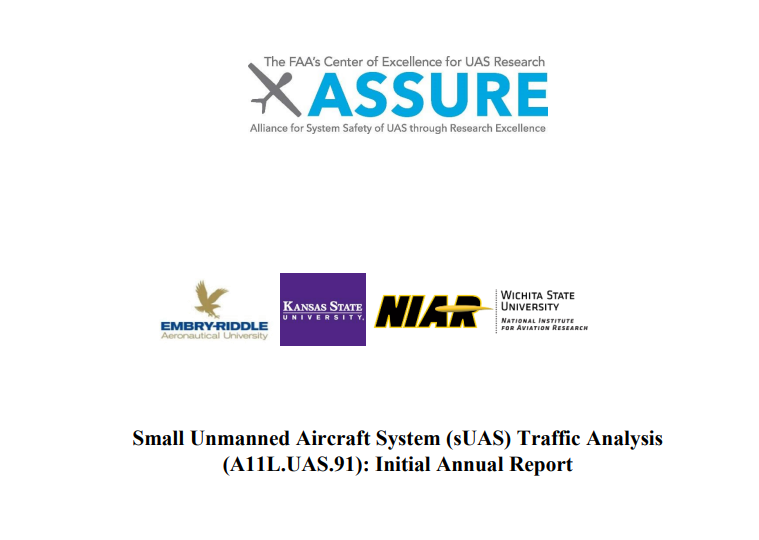Findings from the Alliance for System Safety of UAS through Research Excellence (ASSURE) project A11L.UAS.91: sUAS Traffic Analysis have been published in an Initial Annual Report for the Small Unmanned Aircraft System (sUAS) Traffic Analysis (A11L.UAS.91). The publication presents the progress, findings, and preliminary observations on research tasks completed in the first of three years of this traffic analysis research project.
In order for the FAA to maintain the safety of the NAS and accommodate new types of UAS operations, it is important to monitor the effectiveness of existing UAS regulations and forecast future UAS integration needs. Using detection data, first of its kind, this research provides data to support those needs by analysing sUAS traffic at several urban locations across the NAS.
The project aims to provide low-altitude sUAS traffic data captured via sUAS detection technology at locations throughout the United States to advise the FAA on the state of sUAS operations within the NAS. The availability and analysis of this data is anticipated to assist the FAA to: (1) identify, assess, mitigate, and monitor for sUAS safety hazards; (2) determine the effectiveness of existing sUAS regulations; (3) accurately forecast sUAS traffic levels; and (4) aid in identifying and assessing future aviation risk.
The research data was collected via a nationwide deployment of Unmanned Aircraft System (UAS) detection equipment through collaboration with two companies. Working with these partners provides 166 UAS detection sensors deployed across 64 diverse geographical areas. This instrumentation conducts continuous, passive monitoring of detailed operational data such as identification (electronic serial number), location, altitude, speed, and remote pilot’s location. Data is collected for sUAS vehicles manufactured by DJI, and their market share is estimated at approximately 76% based on sale volume, indicating the system will detect a high proportion of sUAS operations.
The data providers included the OpenSky Network, a provider of ADS-B data; Spire Global, a provider of space-based data; and Airguard, a provider of airspace security software for drone detection.
The preliminary data has produced several insights into sUAS operations. Through the initial data analysis, the research team assessed operations in several key areas, including sUAS flights by location, airspace use, seasonal variation in operations (including holiday spikes in operations), time of day operations, operations by type of sUAS, maximum sUAS flight altitudes, the proximity of operations near airports, sUAS launch locations, sUAS retirement/abandonment rates, and estimated registration compliance. The research team also assessed a comparison of the empirical data against sighting reports.
The initial annual report provides a detailed analysis of these critical research areas. However, in general, some preliminary findings can be summarized. First, clear patterns emerge in sUAS operations based on seasonal variations and time of day. Second, sUAS operations appear, for the most part, to be compliant with regulations for operations in proximity to airports. Third, sUAS retirement/abandonment rates seem to be high, especially after the first 3-4 months of use. Lastly, in general, the initial findings indicate that most sUAS operations conduct their flights in compliance with 14 CFR §107 regulations. The report discusses these findings in detail, along with the supporting data. While these findings are preliminary, the results inform the FAA about the types of and patterns of operations of sUAS in the NAS. This data informs future decisions, policies, and procedures for integrating unmanned and manned operations.
Download the report here
For more information:




